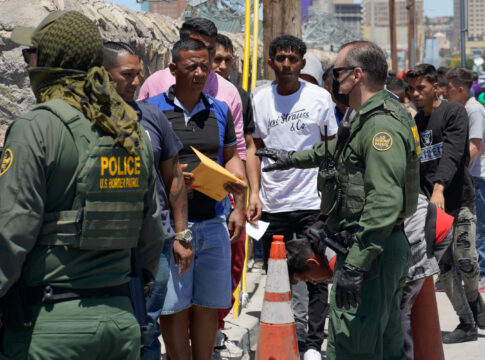Border crossings have dropped to record lows in 2025, but the sweeping executive actions and military deployments fueling this shift are sparking fierce questions about the balance between national security and constitutional limits.
Trump’s 2025 Immigration Crackdown: Drastic Results, Serious Questions
Americans who lived through the Biden border disaster are now watching a hard reset. President Trump wasted no time after taking office in January 2025, signing executive orders that slammed the border shut and sent the military to enforce it. The Department of Homeland Security, Customs and Border Protection, and even the Pentagon now operate in lockstep to secure the southern border in ways never seen before. March 2025 saw just over 7,000 border apprehensions—down from nearly 190,000 in March 2024—a 95% plunge that the White House is touting as the death knell for the so-called “border crisis.”
But while conservatives celebrate the end of open borders and the return to law and order, the scale and speed of these changes have unleashed a political brawl over the proper role of the federal government and the military in domestic affairs. The administration has expanded border wall construction, declared a national emergency, and authorized more than 10,000 troops to operate on U.S. soil. These moves have triggered both applause for restoring security and outrage from critics warning of government overreach. The cost? Nearly $400 million on military border operations by the end of March alone, and a legal battlefield over executive authority that’s still raging.
Militarizing the Border: National Emergency and New Powers
President Trump’s January executive orders didn’t just signal a change—they detonated a bomb under the status quo. Proclamation 10886 declared a national emergency, while Executive Order 14167 gave the U.S. military a direct role in border enforcement. Troops now patrol the southern border, and the Pentagon has set up National Defense Areas and military-controlled zones, effectively giving the Department of Defense unprecedented control over large swaths of border territory. Surveillance, drones, smart walls—tools of warfare are now the tools of border security. This is not the half-hearted “whole-of-government” approach of the past. It’s a full-court press.
Trump’s making America strong again! Secure borders, tougher trade deals, and a military that’s second to none. 🇺🇸 pic.twitter.com/VJg7Py7FZg
— Victoria Byrne (@Thevictoria76) July 10, 2025
The dramatic drop in border crossings is the administration’s proof that these tough measures work. But even some long-time supporters are asking: how long can we keep the military on the border before it starts to feel like martial law? And what happens when the next administration tries to roll these powers back? Legal and operational questions are swirling, with court challenges already underway over the scope of executive authority and the use of the military for domestic law enforcement. For now, the administration is moving full speed ahead, undeterred by the noise from legal activists and open-borders radicals.
Extreme Vetting, Suspended Green Cards, and the New Era of Exclusion
The crackdown isn’t just physical—it’s ideological. Trump’s 2025 immigration plan has revived and expanded the “extreme vetting” regime, requiring every agency to identify “high-risk” countries and propose new entry restrictions. The administration is rolling out a tiered travel ban targeting more than 40 countries, with some facing a blanket prohibition on entry. Visa and immigration policies are under a microscope, and social media accounts are scoured for ideological red flags. Green card processing for refugees and asylees is suspended, with thousands in limbo, unable to complete their applications and now vulnerable to deportation if they can’t renew their status. The policy’s defenders say it’s about national security—no more letting in people who hate America or pose a threat. Critics howl about civil liberties and due process, but the response from Trump’s base is clear: it’s about time the government put Americans first, not illegal aliens or foreign nationals with axes to grind.
The administration is also eyeing a dramatic expansion of earlier travel bans, targeting not just predominantly Muslim countries but any nation deemed a security risk. The rhetoric is tough, and the execution is tougher. This is a message: the days of catch-and-release, open asylum pipelines, and endless appeals are over. The White House is betting that the American public—especially those sick of seeing taxpayer money spent on handouts for illegals—will back this approach, even as the legal wrangling continues.
The Future: Restoring Order or Overreaching Power?
Supporters of these measures see them as a long-overdue course correction after the chaos and lawlessness of the Biden era. The sharp decline in border crossings, the return of the military to a supporting role on U.S. soil, and the restoration of tough vetting standards all point to a government finally doing its job. For conservative Americans, this is what accountability looks like—no more coddling criminals, no more open borders, no more excuses. But the expansion of executive and military power raises questions that even supporters would be wise to consider. How closely should the military be involved in civilian law enforcement? What happens to legitimate refugees and asylees caught in the crossfire? And how far can the executive branch go before it collides with the Constitution itself?
Do you support the US military protecting our borders?
A. Absolutely yes
B. No pic.twitter.com/wf7YtsYgkW— Donald J. Trump Daily 🇺🇸 Commentary (@TrumpRealDaily) July 6, 2025
Right now, the administration is riding high on results. But the ultimate test will be whether these policies can deliver lasting security without undermining the very freedoms and constitutional limits that make America worth defending in the first place. As the legal battles continue and Congress weighs in, the stakes couldn’t be higher—not just for border security, but for the future of American governance itself.
Sources:
Trump’s 2025 Executive Orders: Reshaping Security on the Southern Border
The First 100 Days of the Second Trump Administration
Trump’s Immigration Policies and Project 2025
The Trump Administration’s 2025 Changes to Immigration Law


